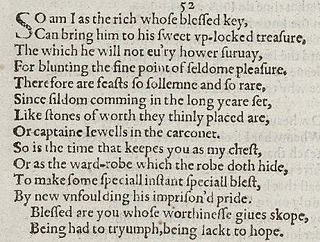
Samuel Daniel (1562–1619) was an English poet, playwright and historian in the late-Elizabethan and early-Jacobean eras. He was an innovator in a wide range of literary genres. His best-known works are the sonnet cycle Delia, the epic poem The Civil Wars Between the Houses of Lancaster and York, the dialogue in verse Musophilus, and the essay on English poetry A Defense of Rhyme. He was considered one of the preeminent authors of his time and his works had a significant influence on contemporary writers, including William Shakespeare. Daniel's writings continued to influence authors for centuries after his death, especially the Romantic poets Samuel Taylor Coleridge and William Wordsworth. C. S. Lewis called Daniel "the most interesting man of letters" whom the sixteenth century produced in England.
Rhyme royal is a rhyming stanza form that was introduced to English poetry by Geoffrey Chaucer. The form enjoyed significant success in the fifteenth century and into the sixteenth century. It has had a more subdued but continuing influence on English verse in more recent centuries.

Heroic verse is a term that may be used to designate epic poems, but which is more usually used to describe the meter(s) in which those poems are most typically written. Because the meter typically used to narrate heroic deeds differs by language and even within language by period, the specific meaning of "heroic verse" is dependent upon context.
This is a glossary of poetry terms.

Sonnet 22 is one of 154 sonnets written by the English playwright and poet William Shakespeare, and is a part of the Fair Youth sequence.

Sonnet 45 is one of 154 sonnets written by the English playwright and poet William Shakespeare. It is a member of the Fair Youth sequence, in which the poet expresses his love towards a young man. Sonnet 45 is continued from Sonnet 44.

Sonnet 49 is one of 154 sonnets written by the English playwright and poet William Shakespeare. It is a member of the Fair Youth sequence, in which the poet expresses his love towards a young man.

Sonnet 51 is one of 154 sonnets written by the English playwright and poet William Shakespeare. It is part of the Fair Youth sequence, in which the poet expresses his love towards a young man. It is a continuation of the argument from Sonnet 50.

Sonnet 52 is one of 154 sonnets written by the English playwright and poet William Shakespeare. It is a member of the Fair Youth sequence, in which the poet expresses his love towards a young man.

Sonnet 61 is one of 154 sonnets written by the English playwright and poet William Shakespeare. It is a member of the Fair Youth sequence, in which the poet expresses his love towards a young man.
Sonnet 132 is one of 154 sonnets written by the English playwright and poet William Shakespeare.

Sonnet 134 is one of 154 sonnets written by the English poet and playwright William Shakespeare. In it, the speaker confronts the Dark Lady after learning that she has seduced the Fair Youth.
Sonnet 149 is one of 154 sonnets written by the English playwright and poet William Shakespeare.

Sonnet 143 is one of 154 sonnets written by the English playwright and poet William Shakespeare.
Sonnet 137 is one of 154 sonnets written by the English playwright and poet William Shakespeare.

Sonnet 90 is one of 154 sonnets written by the English playwright and poet William Shakespeare. It is a member of the Fair Youth sequence, in which the poet expresses his love towards a young man.

Sonnet 95 is one of 154 sonnets written by the English playwright and poet William Shakespeare. It is a member of the Fair Youth sequence, in which the poet expresses his love towards a young man.

Sonnet 96 is one of 154 sonnets written by the English playwright and poet William Shakespeare. It is a member of the Fair Youth sequence.
Sonnet 120 is one of 154 sonnets written by the English playwright and poet William Shakespeare. It's a member of the Fair Youth sequence, in which the poet expresses his love towards a young man.
Decasyllabic quatrain is a poetic form in which each stanza consists of four lines of ten syllables each, usually with a rhyme scheme of AABB or ABAB. Examples of the decasyllabic quatrain in heroic couplets appear in some of the earliest texts in the English language, as Geoffrey Chaucer created the heroic couplet and used it in The Canterbury Tales. The alternating form came to prominence in late 16th-century English poetry and became fashionable in the 17th century when it appeared in heroic poems by William Davenant and John Dryden. In the 18th century famous poets such as Thomas Gray continued to use the form in works such as "Elegy Written in a Country Churchyard". Shakespearean Sonnets, comprising 3 quatrains of iambic pentameter followed by a final couplet, as well as later poems in blank verse have displayed the various uses of the decasyllabic quatrain throughout the history of English Poetry.













